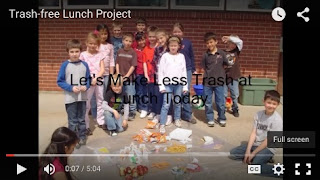A simple project to begin the year is one my class completed a few years ago with great success. If you are new to project based learning but would like to give it a try, pose this challenge to your students and watch them learn!
Can our class complete one week with a trash-free lunch?
How to:
- Pose the challenge to your class.
- Begin by investigating the amount of trash currently generated by one class in a day. Replace the trash liner in the lunch room for your class and have all class members deposit their trash in that liner for the day. Remove the liner and, as a class, examine the contents. Sort, identify, and analyze the trash while wearing gloves.
- As a class, evaluate the contents and create a plan for reducing the amount.
- Research alternatives to categories of trash and strategies used in other schools using online research tools.
- Use the class plan and new knowledge to strive for a trash-free lunch each day for one week.
- Collect and evaluate the gathered trash each day.
- Record and document data and results.
- Produce a multimedia product to share the project and outcome.
There are many skills and standards to teach "just in time" within this project. Sorting and classifying, measurement, research, civics, speaking and listening in classroom discussions, and multimedia production are all possibilities. Based on your grade level standards, there are most certainly more.
Here is the multimedia product created by my class:

Great PBL, Cheryl. I am going to use it for an introduction to PBLs for my class. I think I will tie it to somewhat of a Science "experiment" for observing, gathering data, scientific method, etc. Thanks!
ReplyDeleteThere are so many ways to connect projects to standards! Have fun and may eager learning abound!
DeleteLove this PBL! Great idea!
ReplyDeleteThank you, Sarah!
ReplyDeletenice idea dear
ReplyDeletecheryl you will love this too,
ReplyDeletein Tamilnadu we are working in pbl and last year we got so many prizes.
there is a world level movement called Design for change,
click on this link and you can see amazing works of children.
dfcworld.com
So nice to hear from you, Chitra! Thank you for sharing the link! PBL is a wonderful way to learn.
Delete